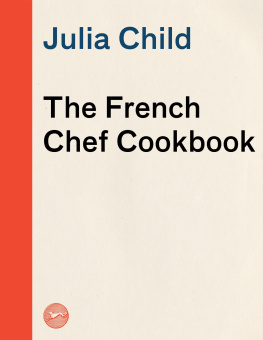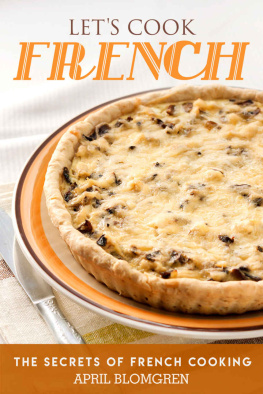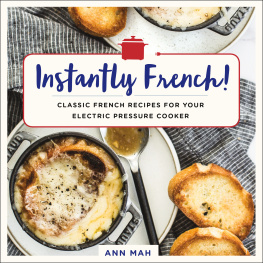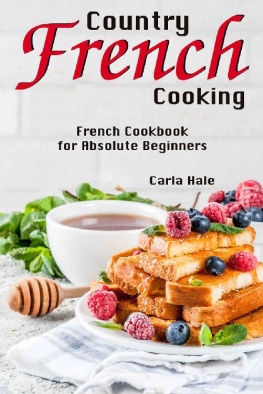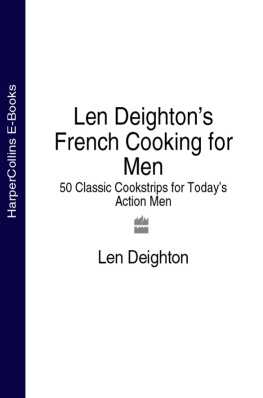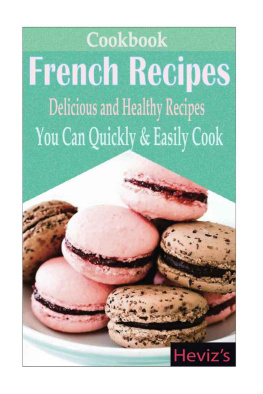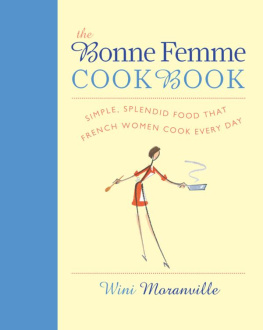FRENCH CLASSICS
MADE EASY
RICHARD GRAUSMAN
Workman Publishing, New York
Copyright 1988, 2011 Richard Grausman
All rights reserved. No portion of this book may be reproducedmechanically, electronically, or by any other means, including photocopyingwithout written permission of the publisher. Published simultaneously in Canada by Thomas Allen & Son Limited.
Library of Congress Cataloging-in-Publication Data is available.
eISBN 9780761165361
Originally published as At Home with the French Classics, now revised and updated.
Cover design: Jean-Marc Troadec Cover photo: Michael Paul/StockFood Munich Interior design: Lisa Hollander Illustrations: Alan Witschonke based on illustrations by Donna Ruff
Workman books are available at special discounts when purchased in bulk for premiums and sales promotions as well as for fund-raising or educational use. Special editions or book excerpts also can be created to specification. For details, contact the Special Sales Director at the address below, or send an e-mail to specialmarkets@workman.com.
Workman Publishing Company, Inc. 225 Varick Street New York, NY 10014-4381 www.workman.com
To Susan, Jennifer, and Deborah, the three loves of my life.
and
To all the C-CAP graduates whose achievements have given my life greater meaning.
ACKNOWLEDGMENTS
There are many people to thank for the creation of this book and for its new life, so I start by offering thanks to Peter Workman for his steadfast support over the years.
In the beginning, there were my loving and nurturing parents, Elizabeth and Roland Grausman, who urged me to find a profession that I would work hard at and enjoy. My passion for cooking was sparked when, while working in the import business, a friend offered me his place at a series of cooking classes with the legendary James Beard, whose praise and encourgement started me thinking in new directions. The spark was ignited and fueled by a two-year stint in Paris at Le Cordon Bleu. The strict, yet gentle and humorous Madame Elisabeth Brassart, who single-handedly resurrected and strengthened the famed school after World War II, supported my interest in teaching and gave me the opportunity of a lifetime. As the schools first and only representative (19691985), I was privileged to bring the tastes and techniques of the Paris school to people in cities across the United States and Canada, doing for them what James Beard had done for me. Thank you Jim and thank you Aunt Lizzy.
I am indebted to my loving wife, Susan, without whose encouragement and assistance this book might never have been written; to my agent, Jane Dystel, whose persistent efforts brought this book to print in the able hands of Workman Publishing; to my very talented brother Philip and nephew David, whose love for the food on these pages keeps me happily busy in the kitchen for family gatherings.
My appreciation to all the dedicated teachers in the Careers through Culinary Arts Program (C-CAP) who have used this book over the past 20 years to inspire their students to broaden their palates and their horizons.
I would like to express my deep gratitude to Kate Slate, whose exceptional editorial and organizational skills helped me to shape this book; to Alan Witschonke, for his illuminating drawings, which add so greatly to the pages; to Jean-Marc Troadec and Lisa Hollander, whose cover and interior design and graphics give this book its fresh new look; to those at Workman Publishing responsible for the production of the book; and special thanks go to my editor, Suzanne Rafer, for her enthusiastic support and overall guidance in the production of this volume. Last, but certainly not least, to all my fans who over the years have told me that my recipes have made them better cooks, their children better eaters, and their spouses happier. For this reaffirmation of my work, I am truly grateful.
CONTENTS
FIRST COURSES
PAGE 14
The perfect entry into a meal, many of these dishes also work well as light lunches or suppers.
MAIN COURSES
PAGE 86
Here are timeless favorites from the repertoire of French main courses simplified for ease in the home kitchen.
VEGETABLES & OTHER ACCOMPANIMENTS
PAGE 170
Enjoy a selection of French dishes that work well as side dishes in an American-style dinner.
PASTRIES & DESSERTS
PAGE 210
Marvelous desserts complete the meal, and the selection in this section can be created without fuss or excessive amounts of time.
BASICS
PAGES 300
These basic recipes are the cornerstone of French cuisine.
INTRODUCTION
For close to four decades I have traveled from coast to coast, teaching and giving demonstrations on classic French cooking for Americans. Although many books have been written on the subject, I have come to realize that just as classical music can be transformed by the individual style and interpretation of the performing artist, so can recipes be played differently and thus made to reflect the personality and sensibilities of the individual cook.
The recipes in this book are my interpretations and updates of French classics, based on my years of teaching. No recipe has been put into this book without my first asking: Is it really delicious? Does it deserve to be re-created? If the answer is yes, I then ask: Is it too rich? Too sweet? Too heavy? Too costly? Does it take too long to prepare? If the answer is yes again, which often is the case, I then go about changing it.
My goal is to provide clear, easy instructions, free of some of the restraints of the classic French kitchen.
The most rewarding part of updating classic recipes is making them more compatible with todays health and calorie concerns. The results are the meals Ive enjoyed day after day with my family and friends, both informally and on the most festive occasions. Over the years I have found that the amounts of salt, sugar, butter, egg yolks, and cream called for in most classic French recipes far exceed the dishes needs. I have, therefore, reduced such ingredients without altering the essential nature of the dishes. Salt, for example, is traditionally called for in all pastry recipes to enhance flavor; I find, however, that if sugar is present, salt is dispensable, and I have adjusted such recipes accordingly.
Most of the techniques used in preparing French classics are handed down from one generation of French chefs to the next by means of a strict apprentice system. Under this system you do as youre told and never ask why. In doing so you learn the one right way. This system of learning may be one of the reasons that French cooking has remained distinctive through the ages and that many of the original techniques are still in use today.
Although I was taught by chefs who trained under this system, I have learned through my own teaching that there is always more than one way to achieve a desired result.
In updating French recipes, my goal is to provide clear, easy instructions, free of some of the restraints of the classic French kitchen and more appropriate to the time constraints of todays busy home cook. Where a step is not imperative, I have eliminated it. If a shortcut works, I have used it. When something can be done in advance, I do it.
It has also been a concern of mine that Americans are intimidated not only by the lengthy, detailed preparation they feel to be inherent in French cooking, but by the ingredients as well. Since my desire is for the American cook to feel comfortable and at home with the French classics, I have used ingredients in this book that for the most part can readily be found at local supermarkets. Items that may not always be available I have made optional or have given other, more accessible ingredients as substitutes.


